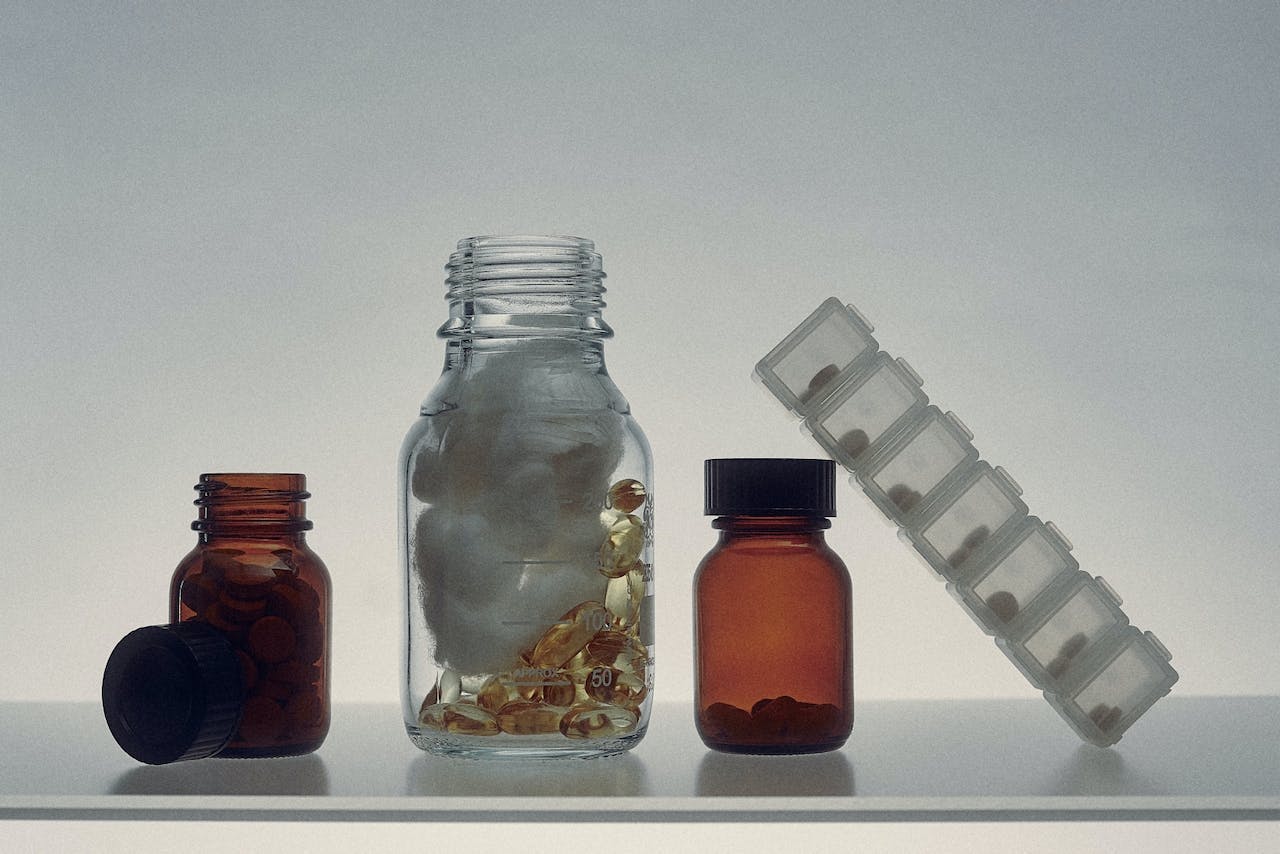Stabilizing your blood glucose levels can help improve your mood and energy levels as well as mitigate insulin resistance, type 2 diabetes, and cardiovascular disease. While a balanced diet and lifestyle are the most effective strategies for glucose regulation, some supplements have been studied for their potential benefits in supporting metabolic health.
Put another way, they won’t magically regulate your glucose levels by themselves, but they can provide micronutrients that support or amplify the effects of a metabolically healthy routine.
If you’re interested in taking supplements to help regulate your blood sugar levels or improve your insulin sensitivity, try one of these four research-backed options.
Note: Many of the studies presented below involve patients with type 2 diabetes or metabolic syndrome, since there is a lack of rigorous research on non-diabetic individuals. While this means that we can’t be sure that healthy people will experience the same results, you can still leverage the insights presented in these studies and try them for yourself, using a tool like a CGM to monitor your own biological data.
1. Cinnamon
Cinnamon, a spice made from the inner bark of the Cinnamomum tree, is a staple in many Middle Eastern, Asian, and Latin American cuisines, as well as a popular addition to baked goods and beverages in the U.S. [1].
While cinnamon has general health benefits — including anti-inflammatory properties and can increase antioxidant concentrations in the blood — it’s also been shown to reduce fasting blood sugar levels, a key marker of metabolic health [2].
One meta-analysis of 16 studies involving pre-diabetic and diabetic subjects found that cinnamon reduced fasting blood glucose levels and HOMA-IR, a diagnotic test that measures insulin sensitivity [3]. According to a review of 7 studies involving subjects with type 2 diabetes, 5 indicated that cinnamon — specifically cassia cinnamon (the most commonly available and used variety) — significantly lowered fasting plasma glucose levels [4]. Doses ranged from 500mg (about a fifth of a teaspoon) to 6g (approximately 2.5 teaspoons), and subjects took cinnamon between 40 days to 4 months.
In addition positive results in diabetic subjects, research in healthy, non-diabetic individuals is also promising. A smaller study of cinnamon’s effects on preprandial (pre-meal) and postprandial (post-meal) glucose levels among 41 adults found that consuming 1g, 3g, or 6g of cinnamon per day for at least 20 days resulted in lower postprandial glucose levels — but only the subjects eating 6g of cinnamon per day saw reduced preprandial glucose levels [5].
The takeaway
Regularly eating or supplementing with cinnamon can help reduce fasting glucose levels. Aim to consume between 1g-6g per day (approximately 0.5-2.5 teaspoons) for at least 20 days to see results. To incorporate cinnamon naturally into your diet, add it to smoothies, marinades (Chinese five spice powder contains cinnamon), yogurt, granola, and more.
2. Chromium
Chromium is a trace mineral that’s found in foods like shellfish (mussels and oysters especially), broccoli, lean beef, whole wheat, and brazil nuts [6]. Not only does chromium help your body metabolize (i.e., break down and absorb) carbohydrates, proteins, and fats, but it may also play a role in blood glucose regulation and the function of the hormone insulin — in fact, people with diabetes tend to have lower levels of chromium than healthy individuals [7, 8].
One pooled analysis of 28 randomized controlled trials found that individuals with type 2 diabetes experienced reduced fasting glucose levels, A1c levels, and triglycerides after taking chromium picolinate or chromium chloride supplements [10]. Another study found that diabetic patients taking 500mcg (micrograms) of chromium twice a day for 2 months experienced lower A1c levels, fasting glucose levels, and fasting insulin levels [11].
That said, other studies and meta-analyses suggest that chromium may have no effect on glucose regulation, or even worsen insulin sensitivity [12, 13].
The takeaway
There’s compelling data to support chromium as a tool to manage blood sugar levels, but more research is needed in healthy, non-diabetic individuals, and not everyone will see results. Since chromium absorption is low (around 1.5-2.5%, with the rest flushed out via urine), try starting with 500mcg of chromium per day (about 12.5mcg absorbed) and working your way up slowly [7]. At the same time, eat chromium-rich foods like shellfish (mussels and oysters especially), broccoli, lean beef, whole wheat, and brazil nuts, all of which are ingredients that can make up a metabolically healthy plate.
3. Berberine
Berberine is a compound found in plants like goldenseal and barberry. It’s part of the alkaloid family, which also consists of caffeine. Recently, berberine has been dubbed by some health gurus and influencers as “nature’s Ozempic” for its touted ability to regulate glucose levels and support weight loss [14]. But is there research to back this up?
Some studies indicate that berberine can in fact help regulate blood sugar levels. In a small study that involved 80 Chinese men and women (ages 60-80) with metabolic syndrome, taking berberine daily for a month led to significantly improved fasting and postprandial glucose levels and insulin sensitivity — even more so than the control group, which followed a protocol involving metformin and thiazolidinedione (both insulin-sensitizing drugs), diet, and exercise [15]. In another study, taking 1g of berberine a day for 3 months lowered fasting blood sugar levels by 20%.
As far as weight loss goes, one systematic review of 12 studies found that supplementing with berberine reduced body weight, BMI, waist circumference, and C-reactive proteins (a marker of inflammation) [17]. To be clear, the weight loss was moderate — participants lost an average of 4.56 pounds and 1.08cm of waist circumference. In a separate study where obese participants took 500mg 3 times per day, weight loss averaged 5 pounds [18]. While any weight loss can support insulin sensitivity and balanced glucose, since fat cells (particularly around the belly) can promote insulin resistance, it’s important to have realistic expectations about berberine’s effects regarding weight.
Like Ozempic and other GLP-1 agonists, berberine isn’t a long-term solution for weight management or an alternative to good nutrition — particularly in those who don’t need to lose weight medically.
The takeaway
Berberine can help regulate blood glucose levels and lead to moderate weight loss. To start, take around 1g (1,000mg) a day to start for at least 3 months, and monitor your glucose levels with a CGM to see if you’re experiencing results.
4. Magnesium
Magnesium is an essential micronutrient that plays an important role in hundreds of other bodily reactions. You can meet your daily needs naturally through diet alone — the five foods with the most magnesium per serving are (in descending order) roasted pumpkin seeds, chia seeds, almonds, spinach, and cashews [19].
Not only is magnesium critical for heart health, it’s also a powerful way to improve glucose metabolism. One systematic review involving participants with a range of metabolic backgrounds found that supplementing with magnesium lowered fasting glucose levels and improved insulin sensitivity [20]. In a small study of 54 patients with type 2 diabetes, taking 300mg of oral magnesium sulfate every day for 3 months lowered fasting glucose levels by almost 32%, as well as 2-hour postprandial glucose [21]. On top of that, two separate meta-analyses — one with more than 1 million participants and another with 536,318 participants — found that magnesium significantly reduces the risk of developing diabetes [22, 23].
If you’re supplementing with magnesium rather than getting it from whole food sources, try taking magnesium glycinate, magnesium L-threonate, or magnesium orotate, which typically have few side effects in humans [24]. Some kinds of magnesium, like sulfate and citrate, have laxative effects and may cause gastrointestinal discomfort if you take too much.
The takeaway
Magnesium can help improve insulin sensitivity and lower fasting glucose levels. The daily intake recommendation for men is around 400mg and 310mg for women [25]. Aim to get magnesium through natural sources (one ounce of roasted pumpkin seeds and one cup of boiled spinach contain almost 310mg of magnesium), but supplement with magnesium glycinate, L-threonate, or orotate if desired.
Key takeaways
- Supplements aren’t a cure-all, but they can be a useful addition to a metabolically healthy lifestyle.
- Research indicates that 1g-6g (approximately 0.5-2.5 teaspoons) per day of cinnamon may help lower fasting glucose levels. Add it to smoothies, marinades, desserts, and more.
- More research involving non-diabetic individuals is needed to determine whether chromium is effective for insulin function and glucose regulation, but try getting around 1,000mg of chromium. Shellfish (mussels and oysters especially), broccoli, lean beef, whole wheat, and brazil nuts are all rich in this mineral.
- Berberine can help with stable glucose levels, weight loss, and even insulin resistance related to PCOS. Take 1,000mg per day for at least 3 months.
- Magnesium is critical for heart health, preventing diabetes, and all-around improved insulin sensitivity and fasting glucose levels. Aim for around 400mg per day if you’re a man and 310mg if you’re a woman from food sources like seeds, nuts, and spinach.
References:
- https://www.britannica.com/plant/cinnamon
- https://pubmed.ncbi.nlm.nih.gov/33066854/
- https://pubmed.ncbi.nlm.nih.gov/31425768/
- https://nutritionj.biomedcentral.com/counter/pdf/10.1186/s12937-015-0098-9.pdf
- https://www.ncbi.nlm.nih.gov/pmc/articles/PMC6425402/
- https://www.webmd.com/diet/foods-high-in-chromium
- https://ods.od.nih.gov/factsheets/Chromium-HealthProfessional/
- https://pubmed.ncbi.nlm.nih.gov/15208835/
- https://www.hsph.harvard.edu/nutritionsource/chromium/
- https://onlinelibrary.wiley.com/doi/abs/10.1002/mnfr.201700438
- https://diabetesjournals.org/diabetes/article/46/11/1786/10196/Elevated-Intakes-of-Supplemental-Chromium-Improve
- https://pubmed.ncbi.nlm.nih.gov/31577642/
- https://bmcendocrdisord.biomedcentral.com/articles/10.1186/1472-6823-12-31
- https://www.nbcnews.com/health/health-news/berberine-supplements-what-to-know-benefits-risks-side-effects-rcna87065
- https://www.ncbi.nlm.nih.gov/pmc/articles/PMC6434235/
- https://www.veri.co/learn/how-to-lose-weight-with-pcos
- https://pubmed.ncbi.nlm.nih.gov/32690176/
- https://www.sciencedirect.com/science/article/abs/pii/S0944711312001870
- https://ods.od.nih.gov/factsheets/Magnesium-HealthProfessional/
- https://pubmed.ncbi.nlm.nih.gov/28526383/
- https://pubmed.ncbi.nlm.nih.gov/25405132/
- https://bmcmedicine.biomedcentral.com/articles/10.1186/s12916-016-0742-z
- https://pubmed.ncbi.nlm.nih.gov/21868780/
- https://www.healthline.com/nutrition/magnesium-types
- https://www.hsph.harvard.edu/nutritionsource/magnesium/


